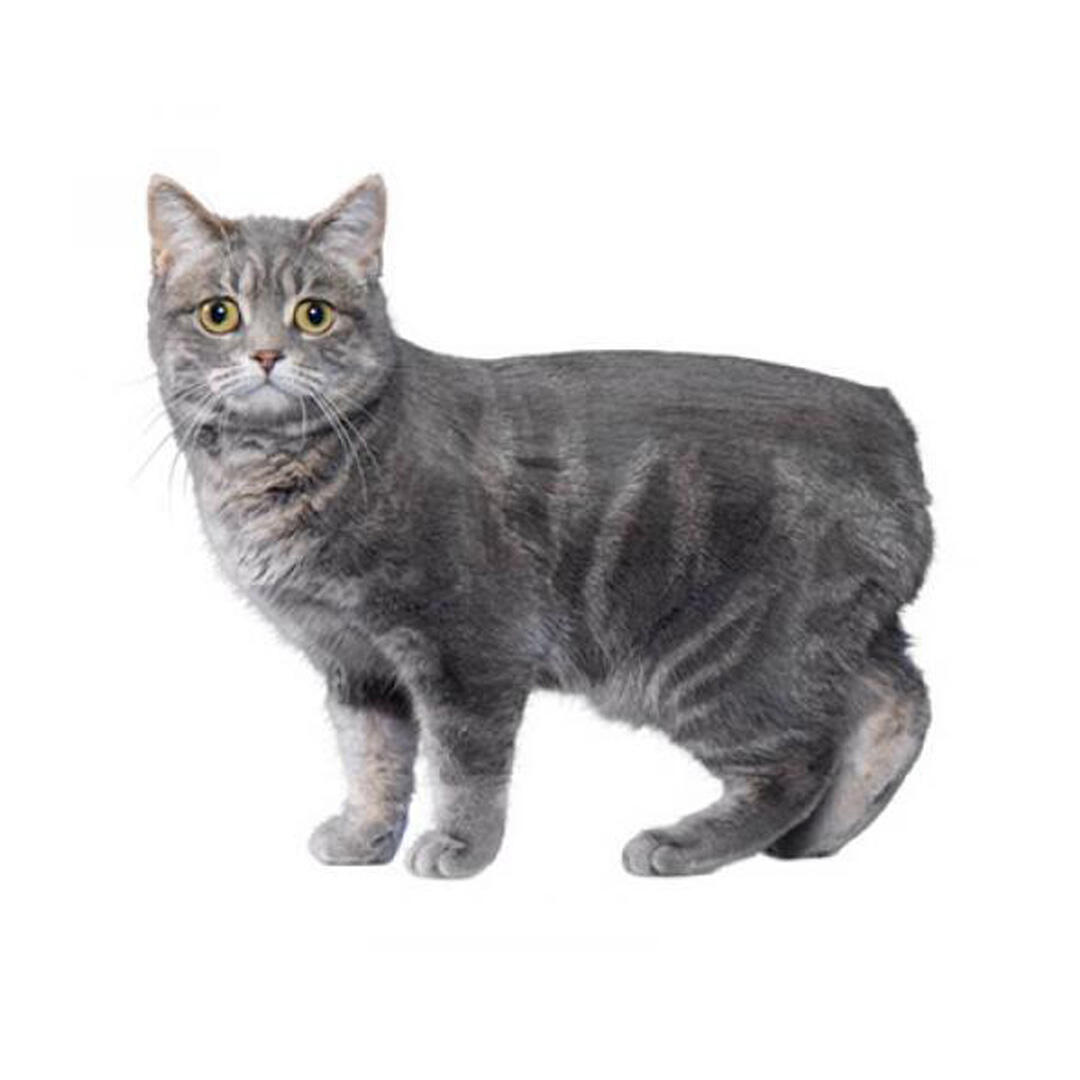
| Family-friendly: | 23/5 |
| Playfulness: | 3/5 |
| Intelligence: | 4/5 |
| Tendency to Vocalise: | 2/5 |
| Likes Other Pets: | 2/5 |
| Grooming needs: | 2/5 |
| Shedding: | 3/5 |
The lack of a tail is a severe genetic defect and the Manx cat's 'deformed' spine may damage the spinal cord and affect nerves to important organs as well as increasing the chance of arthritis developing from an early age. In some cats the anal passage may be narrowed and this can cause bowel blockages.
The Manx cat is famous for their lack of a tail, however, this attractive, round-faced cat actually comes in a tailed variety (known as a stumpy) as well as the tailless type (rumpy). Whether Rumpy or Stumpy, the Manx is a cobby, muscular, and compact cat with short powerful legs. The Manx is built ‘downhill’ with the hind-legs slightly longer than the fore-legs, and has a double coat consisting of a short thick under-coat and a slightly longer over-coat. Tailless Manx should have a rounded rump with absolutely no tail at all, the tailed variety may have a short stumpy tail or anywhere up to a full-length tail.
Social, gregarious, and affectionate with people and other pets they know, the Manx cat can be more aloof with strangers. The Manx has a long history as a working cat, expected to pay their way by mousing and ratting, and the modern Manx cat is perfectly capable of fulfilling this role today, with some Manx cats being particularly feisty and keen on their ‘outdoor pursuits’.
| Family-friendly: | 23/5 |
| Playfulness: | 3/5 |
| Intelligence: | 4/5 |
| Tendency to Vocalise: | 2/5 |
| Likes Other Pets: | 2/5 |
| Grooming needs: | 2/5 |
| Shedding: | 3/5 |
Manx cats originate from the Isle of Man, where the dominant gene that causes the tailless appearance eventually meant most of the island’s cat population either were tailless or carried the gene.
There are many myths surrounding the Manx cat’s appearance, some suggest that Noah closed the Ark doors too quickly, chopping off the tail. Others say that the Manx arrived with the Spanish Armada in 1588, swimming ashore from the wrecked galleons, although there is no evidence a Spanish Galleon was ever wrecked there. Whatever the truth, Manx have been recorded since the early 1800s and were one of the first breeds registered by the Cat Fanciers Association, in 1906.
The Manx is more than capable of outdoor life, but their feline hunting abilities can land them in trouble. Consider keeping the Manx cat in a cat-proofed garden or with a purpose-built cat-run attached to the house.
The Manx will need plenty of cat play, and opportunities to practice hunting via games with toys on strings, and interactive food dispensing toys that recreate catching and dissecting prey. The Manx cat can climb well and so cat trees and other climbing opportunities should be provided.
Although sociable with family, the Manx cat is not likely to feel settled and secure in a very busy home with a constant stream of visitors, or in a home where no one is present much of the day.
Every cat is unique and each has their own particular likes, dislikes, and needs when it comes to food. However, cats are carnivores and every cat must obtain 41 different and specific nutrients from their food. The proportion of these nutrients will vary depending on age, lifestyle, and overall health, so it's not surprising that a growing, energetic kitten needs a different balance of nutrients in her diet than a less active senior cat. Other considerations to bear in mind are feeding the right quantity of food to maintain 'ideal body condition' in accordance with feeding guidelines and catering to individual preference regarding wet or dry cat food recipes. A balanced nutrition plays a vital role in the wellbeing of a cat so along with proper care it can extend the Manx lifespan to 14 years. Find out more about cat feeding guidelines with our article.
The Manx cat has a coat that is fairly easy to care for, and they will do most of the work themselves, however, when it comes to cat grooming, a brush through once a week gives you the opportunity to check for parasites and wounds. Remember that a greasy coat can be evidence that your cat is no longer attempting to groom themselves, which can be indicative of poor or failing health. As with all cats, Manx cats benefit from regular vaccination, parasite control and an annual veterinary health check.
The Manx cat is a versatile, sociable cat and will suit most family homes, with the exception being those that are very busy with a constant stream of strangers visiting, and those with very tiny children who are not old enough to respect a cat’s space and needs.
Is a Manx cat rare?
Although it’s true that Manx cats are hard to find outside certified Manx breeders, they aren’t really that rare. All-white coloured Manxes, however, are very difficult, if not almost impossible, to find.
Is a Manx cat a good pet?
Yes, Manx cats make excellent pets due to their dog-like behaviour and affectionate and devoted demeanour. They’re also highly social and enjoy being around their owners and playing with them.
Why do Manx cats have no tails?
The lack of tails in Manx cats is due to the result of genetic mutation which might have been caused by the inbreeding of British Shorthairs on the Isle of Manx. However, not all Manx cats are tail-less.
What is the life expectancy of a Manx cat?
The Manx cat lifespan can extend to 14 years, but as each cat is different, it can vary depending on nutrition, lifestyle, and environment.